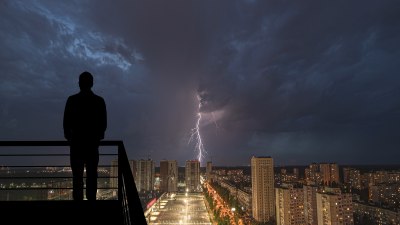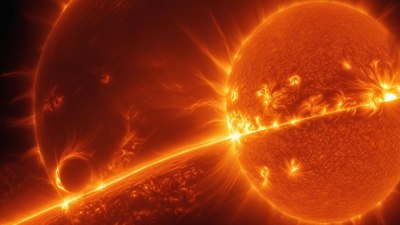Why Certain Texts Feel Like Atmospheric Disturbances
Explore why some texts evoke sensations akin to atmospheric disturbances through literary techniques and emotional resonance.

Image by Freepik
The sensation that certain texts evoke feelings similar to atmospheric disturbances is a fascinating phenomenon that invites exploration into how literature can mimic natural processes. Just as atmospheric disturbances involve dynamic, often disruptive changes in the environment, some literary works seem to unsettle the reader’s emotional or cognitive equilibrium, creating a turbulent but engaging experience. This article delves into why specific texts can feel like atmospheric disturbances, examining the underlying mechanisms and literary strategies that contribute to this effect.
At its core, the comparison between texts and atmospheric phenomena relies on a metaphorical understanding of how both disrupt normal patterns. Atmospheric disturbances, such as storms, turbulent winds, or shifting pressures, alter the physical environment in unpredictable ways. Similarly, certain texts disrupt conventional narrative flows, rearrange linguistic patterns, or introduce psychologically unsettling themes that challenge the reader’s expectations and emotional stability.
Disruptive Narrative Structures
One primary way texts achieve an atmospheric disturbance effect is through disruptive narrative structures. Nonlinear timelines, fragmented storytelling, and unreliable narrators can create a sense of disorientation in the reader, mirroring the confusion brought on by irregular atmospheric conditions. For instance, novels that employ stream-of-consciousness techniques or interwoven timelines demand active mental engagement, causing readers to piece together events much like meteorologists interpret chaotic storm data.
These structural disruptions mimic the turbulence experienced during atmospheric disturbances by breaking the smooth flow of thought. Instead of a straightforward plot progression, the reader encounters sudden shifts in perspective or time, akin to the abrupt changes in pressure or wind patterns found in storms. This structural unpredictability fosters a heightened emotional and cognitive response, intensifying the reader’s immersion and unease.
Use of Language and Sound
The language within such texts often reflects the sensory overload characteristic of atmospheric disturbances. Authors might use jarring, dissonant phonetics or rhythmic disruptions to replicate the cacophony of wind, thunder, or rain. Alliteration, assonance, and consonance can be orchestrated to mimic the auditory sensations accompanying storms, creating a vivid sensory experience. For example, harsh plosives and fricatives might emulate the crackling of thunder or the hissing of wind through trees.
Moreover, the pacing of sentences – alternating between abrupt, clipped phrases and elongated, swirling descriptions – can simulate the erratic tempo of turbulent weather. This rhythmic variation engages the reader’s auditory imagination, fostering a multisensory experience that extends beyond visual imagery to encompass an almost tactile sense of disturbance.
Thematic Resonance with Natural Chaos
Texts that evoke atmospheric disturbances often explore themes aligned with chaos, transformation, and instability. Weather metaphors are powerful literary devices, enabling writers to articulate inner turmoil or societal upheaval through the external environment. A storm might symbolize psychological conflict, emotional upheaval, or a period of significant change, turning the atmosphere into a mirror for human experience.
When a text integrates these themes deeply into its narrative or poetic fabric, readers are drawn into a world where natural and emotional disturbances intertwine. This thematic fusion intensifies the emotional weight of the text, making the atmospheric disturbance not just a metaphor but a pervasive ambiance that saturates the reading experience.
Emotional and Psychological Impact
Certain texts feel like atmospheric disturbances because they trigger profound emotional and psychological reactions. Just as sudden weather changes can induce anxiety or exhilaration, literary works that emulate such disturbances provoke visceral responses. Readers might feel vulnerability, suspense, or catharsis, echoing the unpredictable shifts inherent in turbulent natural settings.
These responses are often facilitated by the narrative’s pacing, the evocative power of imagery, and the intricacy of character development. Intense descriptions of storms or chaotic events within the story enhance the reader’s empathetic connection, allowing personal emotions to resonate with depicted turmoil. This fusion of narrative and experience crafts a powerful sense of disturbance that lingers long after reading.
Interplay Between Reader Expectation and Textual Delivery
The unpredictability that characterizes atmospheric disturbances is paralleled in how a text manages reader expectations. Skilled authors often manipulate anticipation by setting up conventions and then subverting them, much like the unexpected shifts in weather conditions. Plot twists, ambiguous endings, or contradictory character motivations can function as literary equivalents of sudden changes in wind direction or pressure drops that signal a storm.
This interplay disrupts the reader’s cognitive map, creating surprise and engagement simultaneously. The resulting tension mirrors the uneasy anticipation preceding a weather event, keeping readers alert and emotionally invested. Consequently, the text’s delivery acts as an atmospheric system unto itself, dynamically influencing the mood and energy of the reading experience.
Symbolism and Cultural Associations
Atmospheric disturbances carry potent symbolic and cultural associations which texts often exploit to deepen impact. Storms, tempests, and storms have long represented forces beyond human control, such as fate, divine wrath, or natural law. Their integration within literature resonates with deep-seated archetypes and mythological traditions, enriching the reader’s interpretive engagement.
By invoking these motifs, authors tap into a collective unconscious, imbuing their texts with layers of meaning that extend beyond the immediate narrative. The storm-like quality of a text thus becomes a vehicle for exploring existential questions, moral dilemmas, and spiritual journeys, elevating the reading experience from mere storytelling to profound reflection.
Visual and Metaphorical Imagery
Visual imagery associated with atmospheric disturbances plays a critical role in creating this sensation within texts. Descriptions of darkened skies, swirling clouds, crashing waves, or lightning strikes are often employed to dramatize a scene’s emotional intensity or thematic significance. Such imagery can be both literal and metaphorical, simultaneously describing physical environments and symbolic states of mind.
Effective use of this imagery triggers the cognitive process of mental visualization, transporting readers into a liminal space that merges external nature with internal consciousness. The vividness of such depictions fosters immersion, allowing the text itself to act as a storm that envelops the reader in its atmospheric intensity.
Case Studies in Literature
Many renowned works illustrate the phenomenon of texts as atmospheric disturbances. Joseph Conrad’s Heart of Darkness portrays psychological and moral turmoil through a journey layered with stormy rivers and oppressive heat, creating an oppressive ambiance that unsettles the reader. Similarly, Emily Brontë’s Wuthering Heights uses wild, stormy moors as an external reflection of turbulent passions and conflicts within the narrative.
Contemporary literature also embraces this effect. Margaret Atwood’s The Year of the Flood integrates ecological disasters and narrative fragmentation to evoke environmental and social upheavals. The poetic prose and shifting perspectives simulate chaotic atmospheric events, highlighting the instability of both nature and human society.
Psychological Theories and Reader Reception
From a psychological perspective, the feeling of atmospheric disturbance in texts can be linked to cognitive dissonance and emotional contagion. Cognitive dissonance occurs when a reader encounters inconsistencies or tensions within the text that challenge previously held beliefs or expectations. This mental “unease” parallels the discomfort during physical disruptions caused by storms.
Emotional contagion refers to the process whereby emotional states spread between individuals – or from text to reader – enabling immersion in the characters’ or narrative’s emotional climate. When texts depict chaotic or disturbing atmospheric conditions vividly, readers emotionally “catch” these disturbances, internalizing the mood and sensibilities evoked by the narrative.
Music, Rhythm, and Textual Atmospheres
Literary works that feel like atmospheric disturbances often share qualities with musical compositions that depict weather or evoke turbulence. The rhythm and cadence of language can be likened to a musical score where crescendos, diminuendos, and syncopations mirror natural fluctuations in intensity. In this sense, the text’s atmosphere arises not only from semantic content but from its sonic and rhythmic architecture.
For example, poetic forms such as free verse or irregular meter can evoke stormy unpredictability, breaking traditional patterns to convey emotional turbulence. Prose passages that mimic this musicality engage the reader’s auditory imagination, building an immersive and affective atmosphere reminiscent of natural disturbances.
Role of Environment and Setting
Setting is a fundamental tool in producing the sensation of atmospheric disturbance in texts. Physical environments fraught with tempestuous weather, natural disasters, or chaotic landscapes contribute directly to the mood of the narrative. These settings serve as a backdrop against which characters’ struggles and stories unfold, amplifying tension and uncertainty.
Writers carefully craft settings to evoke sensory details— the smell of rain-soaked earth, the tactile sensation of biting wind, the visual drama of lightning—that pull the reader into a world of instability. The strength of this environmental immersion can make the narrative experience feel as immersive and impactful as facing an actual storm.
Interrelation of Textual Elements
The feeling that a text functions as an atmospheric disturbance is rarely produced by a single element alone. Instead, it is the interrelation of narrative disruption, language style, thematic concerns, emotional pacing, imagery, and setting that coalesce to form this effect. Each component interacts dynamically, amplifying the overall sensation of turbulence and unpredictability.
Authors who master this synthesis create works where the reader experiences more than plot or character development; they encounter a living atmosphere that breathes and shifts with every line. This holistic approach transforms reading into an experiential journey akin to navigating a storm, complete with tension, release, and profound transformation.
Impact on Literary Criticism and Interpretation
The recognition that texts can emulate atmospheric disturbances has influenced literary criticism and interpretive paradigms. Critics analyze how storm imagery and narrative turbulence function symbolically and psychologically, enriching understanding of a work’s aesthetic and thematic layers. This approach also highlights the multisensory and embodied nature of reading, emphasizing affect and mood alongside traditional literary analysis.
Furthermore, this perspective encourages readers and scholars to consider how literature interacts with environmental and cultural contexts, particularly in an era increasingly aware of climate change and ecological instability. Textual atmospheres that mirror environmental turbulence gain new relevance, calling attention to the intimate connection between human experience and nature’s unpredictability.
Conclusion: The Text as an Experiential Force
Ultimately, the sensation that certain texts feel like atmospheric disturbances underscores literature’s power to transcend words and become an experiential force. By breaking narrative norms, employing evocative language, integrating symbolic meaning, and engaging emotional and sensory faculties, these texts create immersive atmospheres that resonate deeply with readers.
Through this dynamic interplay, literature becomes akin to a storm—disruptive, transformative, and unforgettable. Understanding why some texts evoke such sensations enriches our appreciation of literary craft and illuminates the profound ways in which words can shape human perception and emotion.











